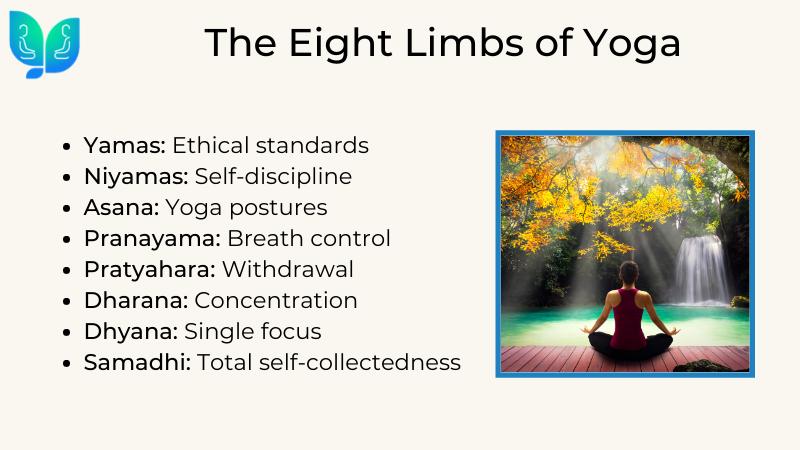

Yoga is a belief system that promotes mindfulness through a mix of movement and meditation. As yoga's popularity has grown around the world, there's been a shift in focus on yoga as simply asanas (poses and movement).
But that's not all there is to yoga.
In my yoga philosophy class on myYogaTeacher, we'll explore the Patanjali Yoga Sutras. I encourage you to sign up for a free two-week trial of myYogaTeacher and join me! In addition to the yoga philosophy class, you'll get access to more than 35 live, online yoga classes with a variety of styles and teachers.
Here, we'll be taking a brief look at who Patanjali was, what the Yoga Sutras are, and why it's so important to know about this side of yoga.
Patanjali (also known as Gonardiya or Gonikaputra) was the author of the Yoga Sutras. These works first gained prominence in the 2nd century BCE and again in the 5th century CE. In addition to the Yoga Sutras, which we'll look at in this article, Patanjali is also credited as being the author, or one of the authors, of Mahabhashya, a defense of grammarian Panini against his main critic Katyayana.

Written by Patanjali, the Yoga Sutras is one of the classic yoga texts and introduced Patanjali's understanding of the Eight Limbs of Yoga. It was originally written in Sanskrit and, despite not even covering the asanas we've learned to associate with yoga, is the most popular and well-recognized techniques for training your body and expanding your mind.
The entire book is a collection of 196 aphorisms that cover everything from art to science to the philosophy of life. It consists of four chapters:
Each attempt to learn the meaning of the Yoga Sutras is said to bring you a step closer to true enlightenment.
Let's look at each of the four chapters more closely.
The first chapter of the Yoga Sutras is Samadhi. It includes 51 sutras and teaches you the foundation of what you need to know about yoga, obstacles to overcome, the importance of abhyasa (constant practice), and vairagya (the detachment from material experiences and worldly pleasures).
Samadhi gets into how the mind works as well as how you can bring peace and calm to your mind with an understanding of mental activities such as:
Patanjali tells us that we can restrict these mental activities through abhyasa and vairagya.

The second chapter of the Yoga Sutras is Sadhana. In this chapter, Patanjali introduces the principles of Ashtanga yoga, Kriya yoga, and Karma as well as the Eight Limbs of Yoga:
The third chapter of the Yoga Sutras is Vibhuti. In this chapter, Patanjali discusses how Dharana, Dhyana, and Samadhi are all connected and pays particular attention to Dhyana and Samadhi.
Dharana means fixing your focus on a single object. Then, focusing and concentrating your mind on the object becomes Dhyana. When the object, and only the object, fills your consciousness entirely, that's Samadhi.
You'll notice that this sounds a lot like meditation. Many times, Dhyana is misinterpreted as "meditation," but it's not exactly the meditation we're familiar with these days. Dhyana is what happens when you can't separate a sense of self from the act of meditation or really even perceive it.
Dharana is actually closer to what we understand modern meditation to be. Through the practice of Dharana, we can better understand our minds, their patterns, and notice the thoughts that interrupt us.
The final chapter of the Yoga Sutras is Kaivalya. In this chapter, Patanjali reflects on the mind's achievements and prepares you for moksha (complete liberation). This liberation comes from the separation of the soul (Purusha) from the source (Prakriti). While separation is often seen as a bad or scary thing, in this case, the soul no longer experiences the misery that comes from this connection.
Now you know a bit more about yoga philosophy and you may be wondering if it really matters? Does knowing more about yoga philosophy really make a difference to your practice?
The answer, as with most things, is "it depends."
Here are three key reasons I think it's important to study Patanjali's Yoga Sutras.
In Western culture, yoga has been distilled into a simple practice of poses and meditation, but yoga is so much more than that. When you learn about the roots of yoga, you can develop a more authentic practice that will not only improve your physical, mental, and emotional health but can transform your life.
I hope you enjoyed this quick look at Patanjali's Yoga Sutras. Don't forget to sign up for a free two-week trial of myYogaTeacher to join me for the next yoga philosophy class or, if you're interested in what else we have to offer, check out 35+ live, online yoga classes every single day.

Receive personalized guidance tailored to your unique fitness goals, live with a dedicated coach—no credit card required.